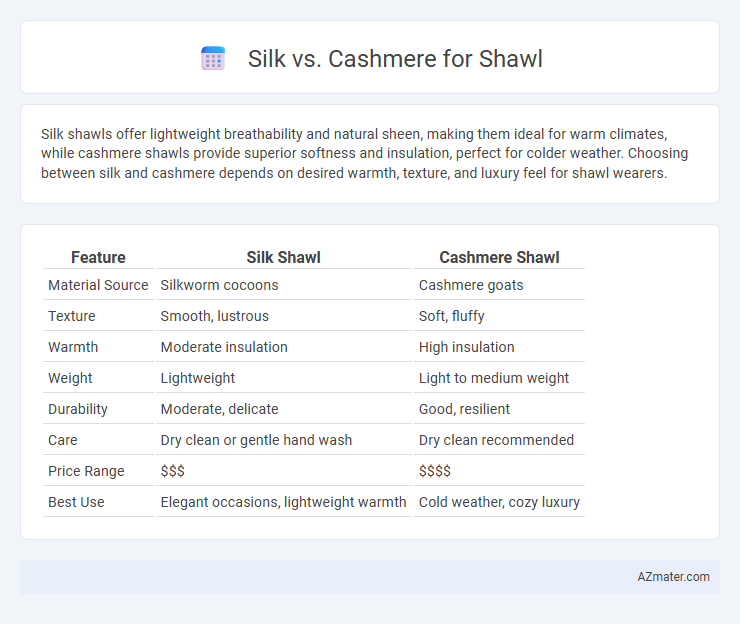Silk shawls offer lightweight breathability and natural sheen, making them ideal for warm climates, while cashmere shawls provide superior softness and insulation, perfect for colder weather. Choosing between silk and cashmere depends on desired warmth, texture, and luxury feel for shawl wearers.
Table of Comparison
| Feature | Silk Shawl | Cashmere Shawl |
|---|---|---|
| Material Source | Silkworm cocoons | Cashmere goats |
| Texture | Smooth, lustrous | Soft, fluffy |
| Warmth | Moderate insulation | High insulation |
| Weight | Lightweight | Light to medium weight |
| Durability | Moderate, delicate | Good, resilient |
| Care | Dry clean or gentle hand wash | Dry clean recommended |
| Price Range | $$$ | $$$$ |
| Best Use | Elegant occasions, lightweight warmth | Cold weather, cozy luxury |
Introduction to Silk and Cashmere Shawls
Silk shawls are prized for their smooth texture, natural sheen, and lightweight warmth, making them ideal for elegant and breathable layering. Cashmere shawls, crafted from the fine undercoat of cashmere goats, offer exceptional softness, insulation, and a luxurious feel that provides superior warmth without bulk. Both materials bring distinct qualities to shawls, with silk emphasizing gloss and drape, while cashmere excels in softness and thermal comfort.
Origins and History of Silk and Cashmere
Silk, originating from ancient China around 2700 BCE, has been prized for its smooth texture and natural sheen, produced by the silkworm larvae's cocoons. Cashmere wool, derived from the undercoat of Cashmere goats native to the Himalayan regions of India, Nepal, and Mongolia, has a history dating back over 2,000 years as a luxury textile known for its exceptional warmth and softness. Both fibers have long-standing cultural significance and have been central to traditional shawl craftsmanship across Asia and the Middle East.
Texture and Feel: Silk vs Cashmere
Silk shawls offer a smooth, cool texture with a natural sheen that feels lightweight and airy against the skin, ideal for warmer climates or elegant occasions. Cashmere shawls provide a plush, soft, and luxurious feel with excellent insulation, making them perfect for colder weather and cozy comfort. The tactile experience of silk is sleek and slippery, while cashmere's texture is dense, fluffy, and warm, appealing to different sensory preferences.
Warmth and Insulation Properties
Cashmere offers superior warmth and insulation compared to silk due to its dense, fine fibers that trap body heat effectively, making it ideal for shawls in cold weather. Silk, while lightweight and breathable, provides moderate warmth but excels in moisture-wicking and temperature regulation, making it suitable for transitional seasons. The choice between silk and cashmere shawls depends on the desired balance between lightweight comfort and maximum insulation.
Durability and Longevity Comparison
Silk shawls offer moderate durability with a smooth texture that resists wear but can be prone to snagging and requires delicate care. Cashmere shawls provide superior longevity due to their resilience and ability to maintain softness over time, making them ideal for frequent use. The natural fibers in cashmere outperform silk in preserving warmth and structural integrity through extended wear.
Breathability and Comfort Factors
Silk shawls offer exceptional breathability due to the natural protein fibers that allow for moisture-wicking and temperature regulation, making them ideal for warmer climates. Cashmere provides superior softness and insulation, ensuring comfort in cooler conditions with its fine, dense fibers that trap heat effectively. Choosing between silk and cashmere depends largely on the desired balance between lightweight breathability and cozy warmth.
Style and Aesthetic Appeal
Silk shawls offer a lustrous sheen and smooth texture that enhances elegance, making them ideal for formal occasions and sophisticated style statements. Cashmere shawls provide a soft, plush feel with a matte finish that exudes warmth and luxury, perfect for cozy, chic aesthetics. Both materials elevate outfits with distinct visual appeal--silk's glossy drape versus cashmere's rich, textured look--catering to diverse fashion preferences.
Care and Maintenance Requirements
Silk shawls require gentle hand washing with mild detergent and should be air-dried away from direct sunlight to preserve their delicate fibers, while cashmere shawls demand dry cleaning or hand washing with a special cashmere shampoo to prevent damage and maintain softness. Avoid wringing silk to prevent distortion, whereas cashmere benefits from gentle pressing with a towel to remove excess water. Both fabrics should be stored in breathable garment bags to protect against moths and moisture.
Price and Value Considerations
Silk shawls generally offer a luxurious feel at a more affordable price point compared to cashmere, making them an accessible option for elegant accessories. Cashmere shawls, though often priced higher due to the rarity and softness of the fiber, provide exceptional warmth and durability, enhancing long-term value. When choosing between silk and cashmere, consumers should weigh initial cost against factors like insulation, longevity, and care requirements to determine the best investment for their wardrobe.
Which Shawl Material is Best for You?
Silk shawls offer a smooth, lightweight texture with natural sheen and excellent breathability, ideal for warmer climates and elegant occasions. Cashmere shawls provide superior warmth, softness, and insulation, making them perfect for colder weather and luxurious comfort. Choosing between silk and cashmere depends on your climate needs, desired warmth, and preference for texture and style.

Infographic: Silk vs Cashmere for Shawl
 azmater.com
azmater.com